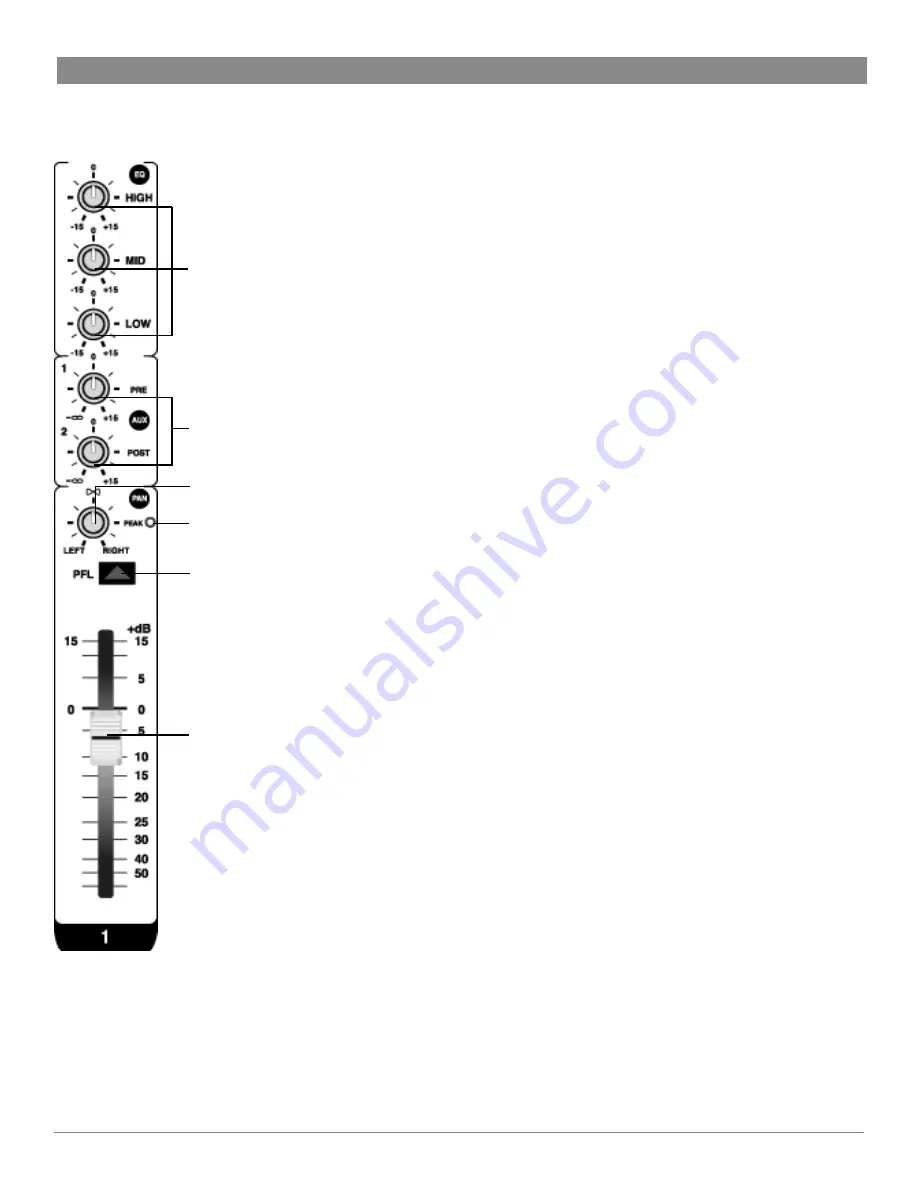
Low Cut filter (3) is an integral
part of the overall equalization
of a mono channel. The chan-
nel EQ is a valuable feature of
the mixer as it allows the user
to control the tonal characteris-
tics of each instrument sepa-
rately. For example, boosting
the LOW can fatten the sound
and add punch to the bass or
drums; the MID control can be
used to define the midrange or
bring out the vocals; and
adjusting the HIGH control can
provide a crisp sounding high
end. With the LOW set to
boost, and the Low Cut switch
activated, you get peak
response rather than shelving
at the bottom end. This is use-
ful for adding warmth to vocals
and instruments, and good for
tight but deep bass (without
losing control of your subwoofer
speaker cones). Another very
important, yet often overlooked
technique is to use the EQ to
subtract from the mix. Cutting
the HIGH control can reduce
unwanted hiss during multi-
track recording, while attenuat-
ing the MID or LOW can elimi-
nate feedback in a live perform-
ance or clear up a muddy
sounding mix. Cutting away the
top and bottom, then pushing
up the Gain is equivalent to mid
range boost!
[Note: Always reset a channel’s
input Gain (or external devices’
output level) after altering the
amount of mixer equalization
cut or boost applied.]
The key to successful equaliza-
tion is to avoid excess. Too
much equalization on the input channels will result in a mix
that is smeared together with nothing specifically defined.
During rehearsals, experiment with the equalizer controls on
various instruments, vocals and combinations of these mixed
together to become familiar with various equalizer settings.
C O N T R O L S A N D C O N N E C T I O N S
7
(6) AUX SEND 1, 2 CONTROLS
Both Aux Sends are mono and post-EQ and control the level
of the signals sent to the AUX buses.
• Aux Send 1 is pre-fader and the signal sent to the
AUX 1 bus will be unaffected by the channel fader
setting.
• Aux Send 2 is post-fader and the signal level sent
to the AUX 2 bus will be affected by the channel
fader setting.
For almost all effects send purposes, you will want to use the
post-fader AUX 2, so that when a fader level is adjusted, any
reverb send from that channel follows the fader. Otherwise,
when the fader is pulled down, the reverb from that channel
would still be audible. Most reverbs etc. internally sum the left
and right inputs so that you can use AUX 2. You can also use
this AUX 2 send to feed inputs to a multi-track recorder or any
other unbalanced line level application.
On the other hand, for cueing purposes and monitor ampli-
fiers, use the pre-fader AUX 1 (i.e. independent of the chan-
nel fader)
(7) PAN CONTROL
The Channel Pan positions the output of the channel in the
stereo field of the Master Mix. Its constant-power design
ensures there are no level discrepancies whether a signal is
hard-panned, center-stage, or somewhere in-between.
(8) PEAK LED INDICATOR
The Peak LED illuminates when a channel is going into over-
load. It detects the peak level after the EQ and will light at
3dB before clipping to warn that the signal is approaching
overload. You do not want the Peak LED to light except very
intermittently during a take or a mix. If it does light persistent-
ly, reduce input gain with the TRIM control (4).
(9) PFL SELECT SWITCH
The PFL (pre-fader listen) switch enables monitoring the
mono signal of any channel(s) selected (button depressed) at
nominal levels though the headphone or control room monitor
outputs [In order to monitor the PFL channels selected, you
must also set the Master/PFL to Control Room switch (20)
to the button depressed (PFL) position].
The signal is post EQ and independent of channel fader posi-
tion. Selecting the PFL never interrupts the main stereo out or
the AUX sends.
(10) CHANNEL FADER
The channel faders determine the output signal level to the
Master Mix bus. They offer a smooth logarithmic taper more
often associated with much more expensive consoles for opti-
mum control of the signal.
(5)
(6)
(8)
(7)
(9)
(10)
Summary of Contents for SRM SERIES
Page 13: ...BLOCK DIAGRAM 13...
Page 14: ...NOTES 14...

































